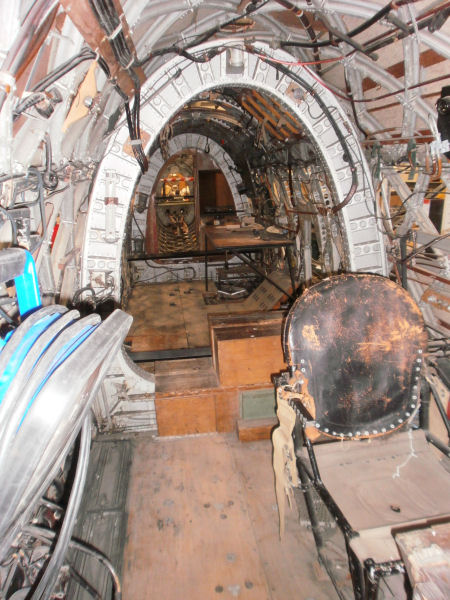Aircraft Restoration at the RAF Museum, Cosford
By Michael J. Gething
It has become a tradition for the Michael Beetham Conservation Centre (MBCC), located at the RAF Museum adjacent to RAF Cosford, to open its doors to visitors to coincide with the week immediately following the Scale Model World exhibition, organised by IPMS(UK). So, at 09:50 on 9 November 2015, I found myself in the company of several other IPMS members assembling in the car park to await the 10:00 opening.
The MBCC – named after the late Marshal of the Royal Air Force, Sir Michael Beetham – opened in May 2002 and is responsible for the care and upkeep of aircraft and what is delightfully described as “other large 3-D artefacts” in the RAF Museum (which has its northern location at RAF Cosford, near Telford, and the original site at Hendon, north London, in the south of the country), as well as exhibits on loan to the Museum.
The work is carried out by a full-time staff of 19 professional technicians and apprentices, aided and abetted by a team of dedicated and trained volunteers. Each project on which they work presents its own challenges as they journey back in time, utilising old or forgotten skills to repair, restore or replicate the original. The staff often find themselves moving from one project to another, as priorities change or a particular process meets a delay of some sort.
The Handley Page Hampden TB Mk I (recovered from Russia and with the MBCC since it opened) is a case in point. However, since the discovery of some Hampden spares in Canada, the restoration has moved forward, with the rear fuselage and tail complete. Current work is concentrating on the centre fuselage and a rebuild of the nose forward of bulkhead 7.
The Vickers Wellington Mk X (MF628) only arrived at the MBCC in 2010, having been on display at Hendon since 1972. The wings are now free of corrosion and have been painted in a protective coating, with the fuselage expected to begin the same process soon. The structure will then be re-covered in Irish linen, doped and painted. It is expected to complete its restoration by about early 2018.
However, the project which many of the visitors were anxious to view was the progress on the remains of the Dornier Do 17Z-2 bomber (the identity of which is believed to be Werk no. 1160) recovered from the English Channel two years ago. It was shot on 26 August 1940 during the Battle of Britain, most probably by a Boulton Paul Defiant Mk I of 264 Squadron. Coming down into the sea off east Kent at about 13:40, the pilot and observer were wounded and taken prisoner; the gunner and wireless operator were killed. (No surprise then, that Airfix has brought its new tool 1/72 scale kits of the Do 17 and Defiant together in their Dogfight Doubles series.)
Two years ago, the recovered structure of the Do 17 was housed in special ‘polybag’ chambers being sprayed with a solution of citric acid to neutralise the effects of sea water corrosion on the aluminium and magnesium-aluminium alloy in the structure. This has now been completed and the various parts of the aircraft recovered now reside within the MBCC’s main workshop hangar, pending a decision on exactly how the Museum intends to display the artefact.
Also in evidence was the Luft Verkehrs Gesellschaft (L.V.G) C VI reconnaissance aircraft from 1918, formerly with the Shuttleworth Trust. Although maintained in airworthy condition for many years, it will not fly again after restoration is complete. As the work has evolved, it was discovered that parts from two or three different machines are contained in the structure, suggesting a much earlier ‘cannibalisation’ to produce a serviceable example.
The MBCC has also completed an overhaul of Supermarine Spitfire PR Mk XIX (PM651), a former ‘gate guardian’ at RAF Benson, to be displayed in Bahrain in 2016. Built in 1945, it did not see service during WW2 but served on meteorological duties at RAF Woodvale in the mid-1950s. It also featured as a static airframe in the 1968 movie ‘The Battle of Britain’.
To illustrate the diversity of the Centre’s skills, it is also working on the restoration of a Range Safety Launch (no. 1667). Built in 1956, it was originally used to tow Sunderland flying boats to mooring buoys at RAF Seletar in Singapore in the early 1960s before working on search-and-rescue, target-towing and weapon recovery duties there and, later, in the UK. It was withdrawn in 1981 and donated to the Museum in 1996.
What was impressed me most about the MBCC (apart from the aircraft) was the importance paid to preserving the skills associated with aircraft construction from an earlier time, enabling conservation and restoration to be passed on to future generations. To this end, the Centre employs six aircraft-trade apprentices (one of which is female), all of whom were very enthusiastic about the work they do. So, should you get to the Cosford museum (where entry is currently free), don’t forget to make a donation to ensure their work continues. You know it makes sense.

















